water pump Hyundai Elantra 2006 Owner's Manual
[x] Cancel search | Manufacturer: HYUNDAI, Model Year: 2006, Model line: Elantra, Model: Hyundai Elantra 2006Pages: 277, PDF Size: 10.18 MB
Page 16 of 277
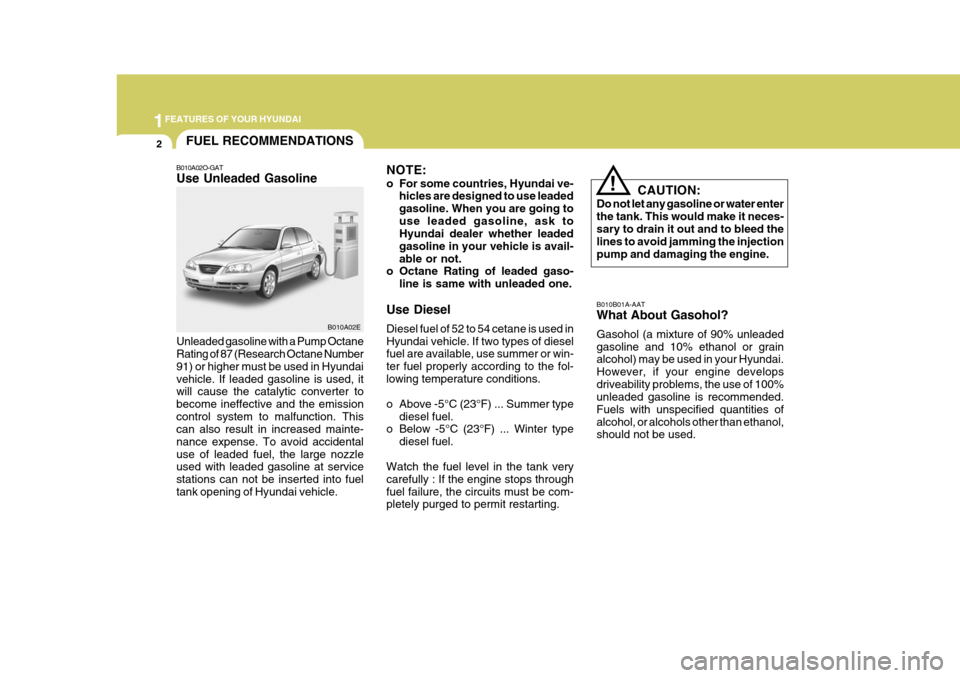
1FEATURES OF YOUR HYUNDAI
2
B010B01A-AAT What About Gasohol? Gasohol (a mixture of 90% unleaded gasoline and 10% ethanol or grain alcohol) may be used in your Hyundai. However, if your engine developsdriveability problems, the use of 100% unleaded gasoline is recommended. Fuels with unspecified quantities ofalcohol, or alcohols other than ethanol, should not be used.
B010A02O-GAT Use Unleaded Gasoline Unleaded gasoline with a Pump Octane Rating of 87 (Research Octane Number 91) or higher must be used in Hyundaivehicle. If leaded gasoline is used, it will cause the catalytic converter to become ineffective and the emissioncontrol system to malfunction. This can also result in increased mainte- nance expense. To avoid accidentaluse of leaded fuel, the large nozzle used with leaded gasoline at service stations can not be inserted into fueltank opening of Hyundai vehicle. NOTE:
o For some countries, Hyundai ve-
hicles are designed to use leaded gasoline. When you are going touse leaded gasoline, ask to Hyundai dealer whether leaded gasoline in your vehicle is avail-able or not.
o Octane Rating of leaded gaso-
line is same with unleaded one.
Use Diesel Diesel fuel of 52 to 54 cetane is used in Hyundai vehicle. If two types of diesel fuel are available, use summer or win- ter fuel properly according to the fol-lowing temperature conditions.
o Above -5°C (23°F) ... Summer type diesel fuel.
o Below -5°C (23°F) ... Winter type
diesel fuel.
Watch the fuel level in the tank very carefully : If the engine stops throughfuel failure, the circuits must be com- pletely purged to permit restarting. CAUTION:
Do not let any gasoline or water enter the tank. This would make it neces-sary to drain it out and to bleed the lines to avoid jamming the injection pump and damaging the engine.
!
B010A02E
FUEL RECOMMENDATIONS
Page 64 of 277
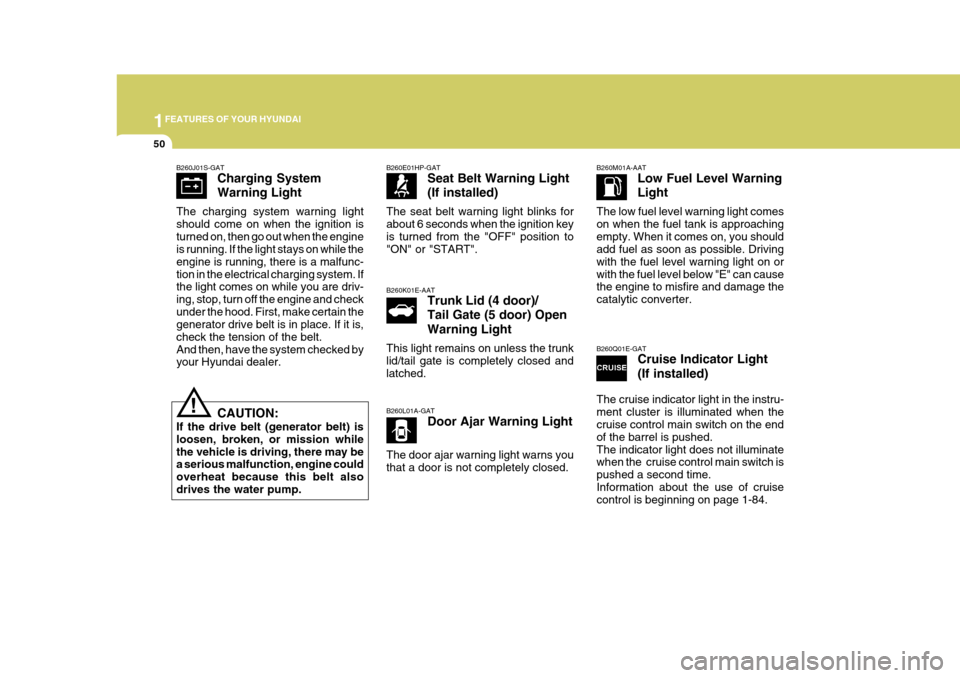
1FEATURES OF YOUR HYUNDAI
50
B260J01S-GAT
Charging System Warning Light
The charging system warning light should come on when the ignition isturned on, then go out when the engine is running. If the light stays on while the engine is running, there is a malfunc-tion in the electrical charging system. If the light comes on while you are driv- ing, stop, turn off the engine and checkunder the hood. First, make certain the generator drive belt is in place. If it is, check the tension of the belt.And then, have the system checked by your Hyundai dealer.
CAUTION:
If the drive belt (generator belt) is loosen, broken, or mission whilethe vehicle is driving, there may be a serious malfunction, engine could overheat because this belt alsodrives the water pump.
!
B260E01HP-GAT Seat Belt Warning Light (If installed)
The seat belt warning light blinks for about 6 seconds when the ignition keyis turned from the "OFF" position to "ON" or "START". B260K01E-AAT Trunk Lid (4 door)/ Tail Gate (5 door) Open Warning Light
This light remains on unless the trunk lid/tail gate is completely closed and latched. B260L01A-GAT Door Ajar Warning Light
The door ajar warning light warns you that a door is not completely closed.B260M01A-AAT Low Fuel Level Warning Light
The low fuel level warning light comes on when the fuel tank is approachingempty. When it comes on, you should add fuel as soon as possible. Driving with the fuel level warning light on orwith the fuel level below "E" can cause the engine to misfire and damage the catalytic converter. B260Q01E-GAT Cruise Indicator Light (If installed)
The cruise indicator light in the instru- ment cluster is illuminated when the cruise control main switch on the end of the barrel is pushed.The indicator light does not illuminate when the cruise control main switch is pushed a second time.Information about the use of cruise control is beginning on page 1-84.
Page 67 of 277
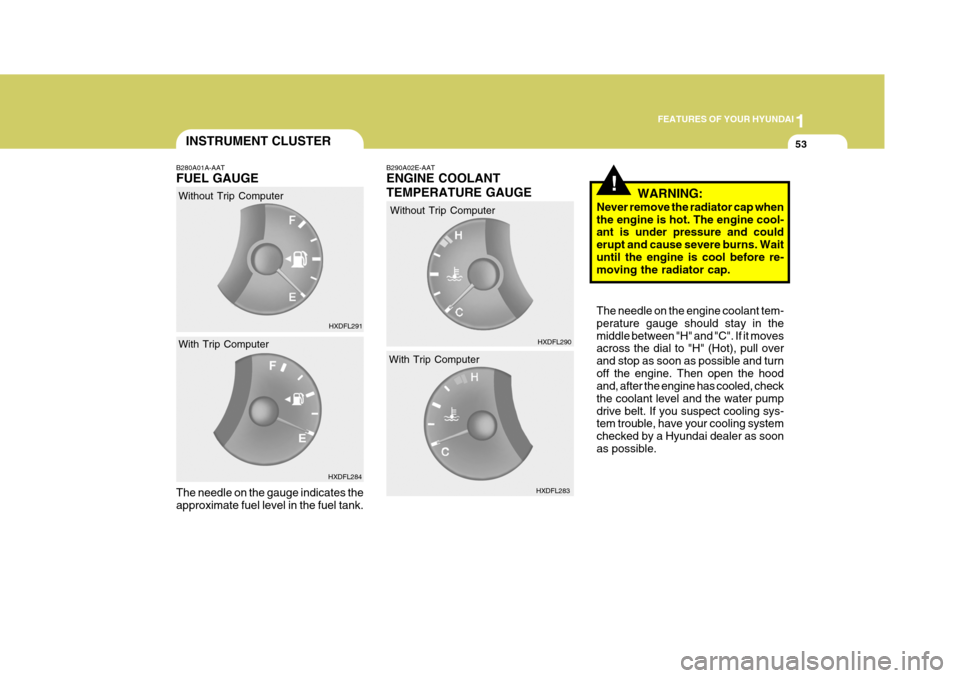
1
FEATURES OF YOUR HYUNDAI
53
!
B280A01A-AAT FUEL GAUGE The needle on the gauge indicates the approximate fuel level in the fuel tank. B290A02E-AAT ENGINE COOLANT TEMPERATURE GAUGE
Without Trip Computer With Trip Computer HXDFL291
HXDFL290
HXDFL284 HXDFL283
Without Trip Computer
With Trip Computer WARNING:
Never remove the radiator cap when the engine is hot. The engine cool- ant is under pressure and could erupt and cause severe burns. Waituntil the engine is cool before re- moving the radiator cap. The needle on the engine coolant tem- perature gauge should stay in themiddle between "H" and "C". If it moves across the dial to "H" (Hot), pull over and stop as soon as possible and turnoff the engine. Then open the hood and, after the engine has cooled, check the coolant level and the water pumpdrive belt. If you suspect cooling sys- tem trouble, have your cooling system checked by a Hyundai dealer as soonas possible.
INSTRUMENT CLUSTER
Page 172 of 277
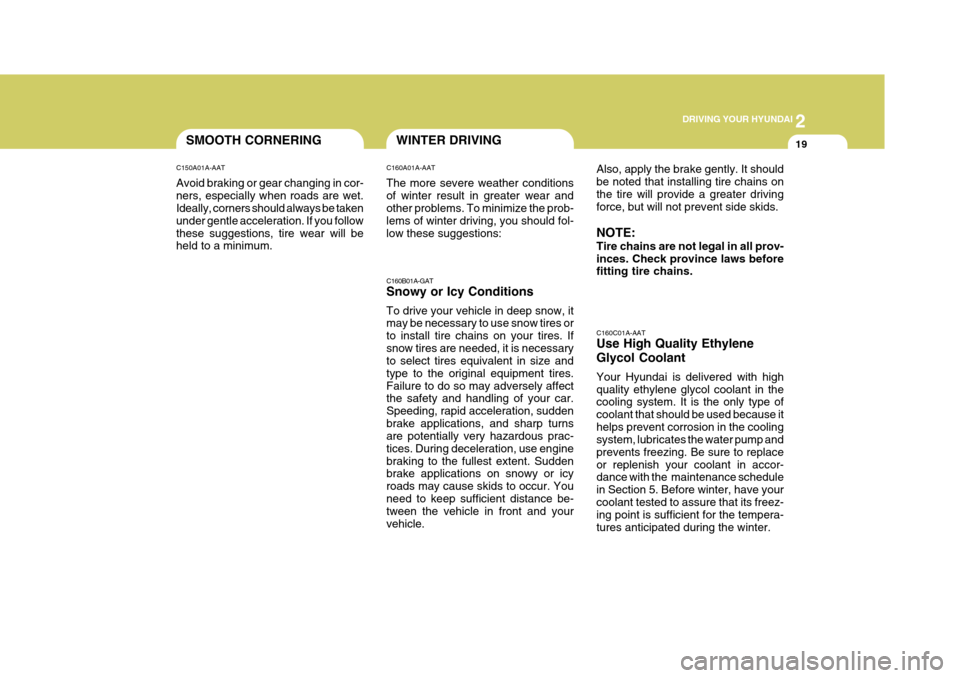
2
DRIVING YOUR HYUNDAI
19SMOOTH CORNERINGWINTER DRIVING
C160A01A-AAT The more severe weather conditions of winter result in greater wear and other problems. To minimize the prob- lems of winter driving, you should fol-low these suggestions:
C150A01A-AAT Avoid braking or gear changing in cor- ners, especially when roads are wet. Ideally, corners should always be taken under gentle acceleration. If you followthese suggestions, tire wear will be held to a minimum. Also, apply the brake gently. It should be noted that installing tire chains onthe tire will provide a greater driving force, but will not prevent side skids. NOTE: Tire chains are not legal in all prov- inces. Check province laws before fitting tire chains.
C160B01A-GAT Snowy or Icy Conditions To drive your vehicle in deep snow, it may be necessary to use snow tires or to install tire chains on your tires. Ifsnow tires are needed, it is necessary to select tires equivalent in size and type to the original equipment tires.Failure to do so may adversely affect the safety and handling of your car. Speeding, rapid acceleration, suddenbrake applications, and sharp turns are potentially very hazardous prac- tices. During deceleration, use enginebraking to the fullest extent. Sudden brake applications on snowy or icy roads may cause skids to occur. Youneed to keep sufficient distance be- tween the vehicle in front and your vehicle. C160C01A-AAT Use High Quality Ethylene Glycol Coolant Your Hyundai is delivered with high quality ethylene glycol coolant in the cooling system. It is the only type of coolant that should be used because ithelps prevent corrosion in the cooling system, lubricates the water pump and prevents freezing. Be sure to replaceor replenish your coolant in accor- dance with the maintenance schedule in Section 5. Before winter, have yourcoolant tested to assure that its freez- ing point is sufficient for the tempera- tures anticipated during the winter.
Page 183 of 277
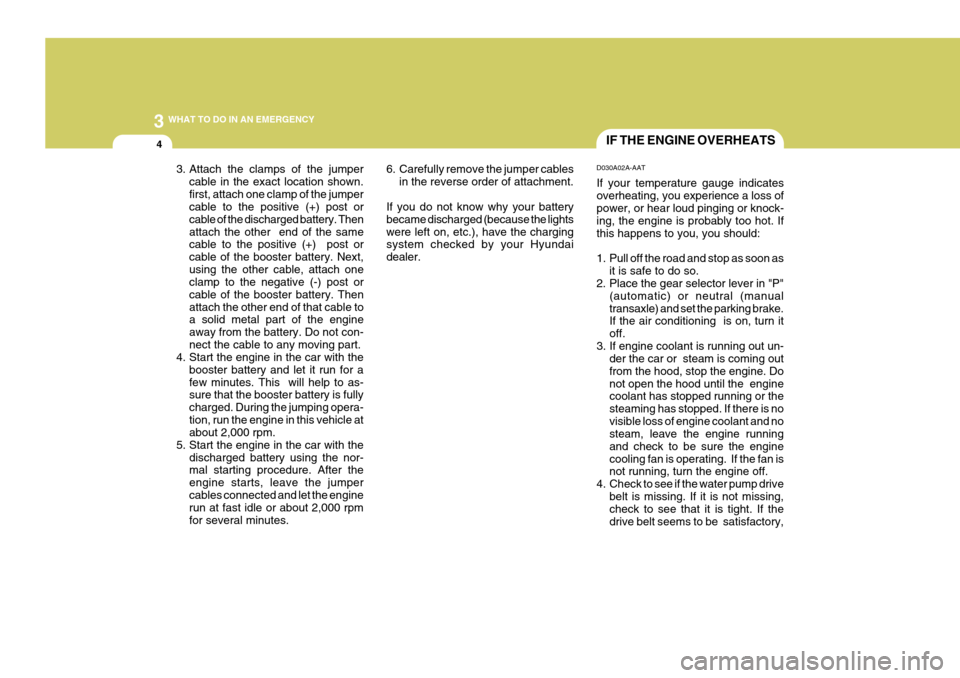
3 WHAT TO DO IN AN EMERGENCY
4IF THE ENGINE OVERHEATS
D030A02A-AAT If your temperature gauge indicates overheating, you experience a loss of power, or hear loud pinging or knock- ing, the engine is probably too hot. Ifthis happens to you, you should:
1. Pull off the road and stop as soon as it is safe to do so.
2. Place the gear selector lever in "P"
(automatic) or neutral (manual transaxle) and set the parking brake. If the air conditioning is on, turn it off.
3. If engine coolant is running out un- der the car or steam is coming outfrom the hood, stop the engine. Donot open the hood until the engine coolant has stopped running or the steaming has stopped. If there is novisible loss of engine coolant and no steam, leave the engine running and check to be sure the enginecooling fan is operating. If the fan is not running, turn the engine off.
4. Check to see if the water pump drive belt is missing. If it is not missing,check to see that it is tight. If the drive belt seems to be satisfactory,
3. Attach the clamps of the jumper
cable in the exact location shown.first, attach one clamp of the jumper cable to the positive (+) post or cable of the discharged battery. Thenattach the other end of the same cable to the positive (+) post or cable of the booster battery. Next,using the other cable, attach one clamp to the negative (-) post or cable of the booster battery. Thenattach the other end of that cable to a solid metal part of the engine away from the battery. Do not con-nect the cable to any moving part.
4. Start the engine in the car with the
booster battery and let it run for afew minutes. This will help to as- sure that the booster battery is fully charged. During the jumping opera-tion, run the engine in this vehicle at about 2,000 rpm.
5. Start the engine in the car with the discharged battery using the nor-mal starting procedure. After the engine starts, leave the jumpercables connected and let the engine run at fast idle or about 2,000 rpm for several minutes. 6. Carefully remove the jumper cables
in the reverse order of attachment.
If you do not know why your batterybecame discharged (because the lightswere left on, etc.), have the charging system checked by your Hyundai dealer.
Page 184 of 277
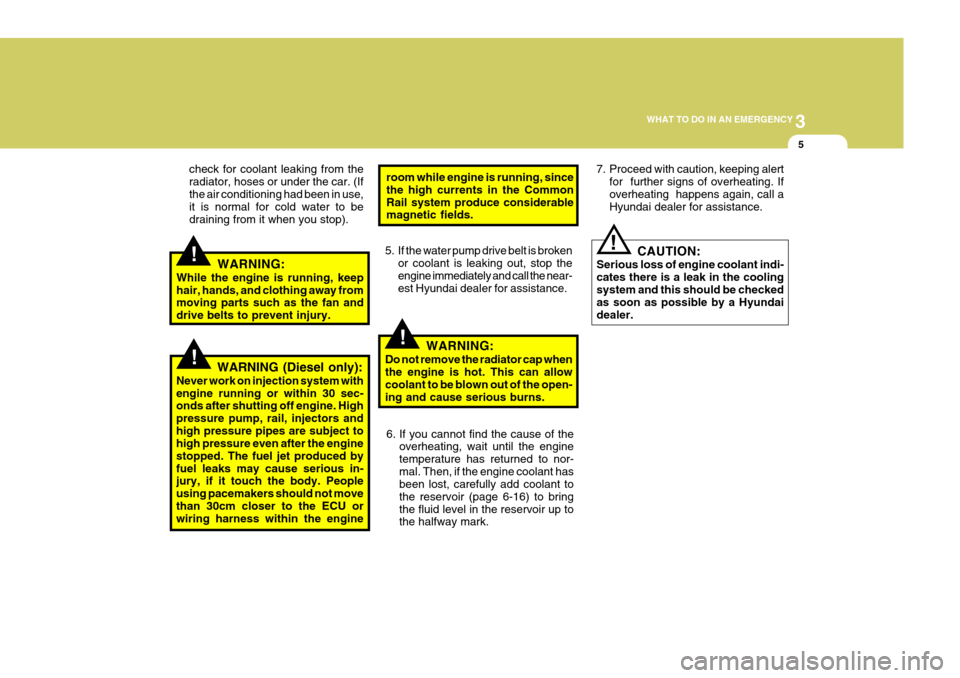
3
WHAT TO DO IN AN EMERGENCY
5
!
!
!
check for coolant leaking from the radiator, hoses or under the car. (Ifthe air conditioning had been in use, it is normal for cold water to be draining from it when you stop).
WARNING:
While the engine is running, keephair, hands, and clothing away from moving parts such as the fan and drive belts to prevent injury. 5. If the water pump drive belt is broken
or coolant is leaking out, stop the engine immediately and call the near- est Hyundai dealer for assistance.
WARNING:
Do not remove the radiator cap when the engine is hot. This can allow coolant to be blown out of the open-ing and cause serious burns.
WARNING (Diesel only):
Never work on injection system withengine running or within 30 sec- onds after shutting off engine. High pressure pump, rail, injectors andhigh pressure pipes are subject to high pressure even after the engine stopped. The fuel jet produced byfuel leaks may cause serious in- jury, if it touch the body. People using pacemakers should not movethan 30cm closer to the ECU or wiring harness within the engine
!
6. If you cannot find the cause of the overheating, wait until the engine temperature has returned to nor-mal. Then, if the engine coolant has been lost, carefully add coolant to the reservoir (page 6-16) to bringthe fluid level in the reservoir up to the halfway mark. CAUTION:
Serious loss of engine coolant indi- cates there is a leak in the coolingsystem and this should be checked as soon as possible by a Hyundai dealer.
room while engine is running, sincethe high currents in the CommonRail system produce considerable magnetic fields.
7. Proceed with caution, keeping alert
for further signs of overheating. If overheating happens again, call a Hyundai dealer for assistance.
Page 202 of 277
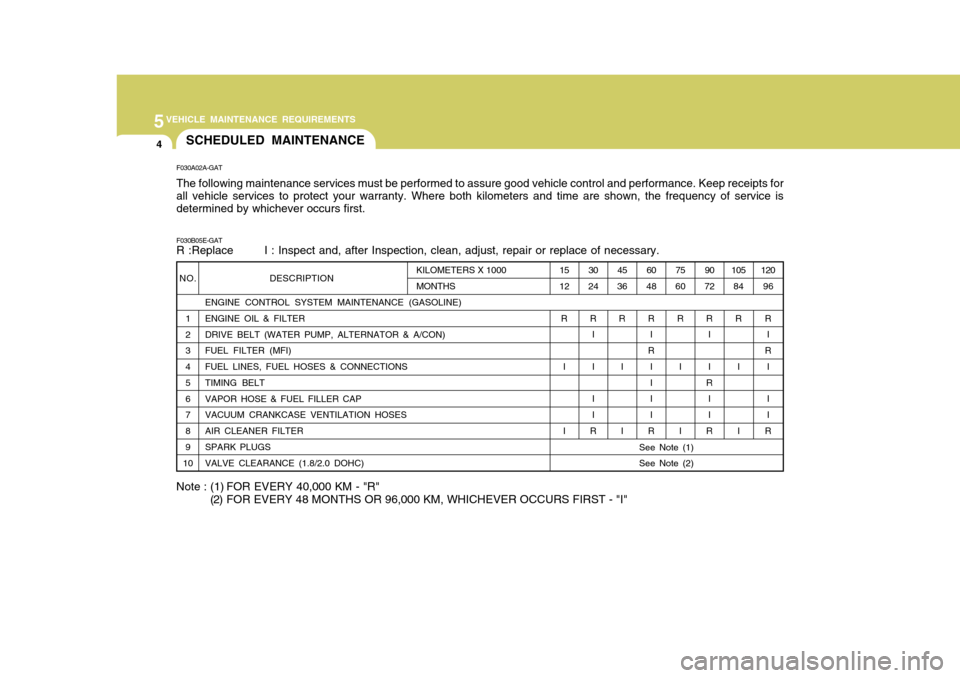
5VEHICLE MAINTENANCE REQUIREMENTS
4
NO.
1 23 4 5 6 7 8 9
10 DESCRIPTION
ENGINE CONTROL SYSTEM MAINTENANCE (GASOLINE) ENGINE OIL & FILTER DRIVE BELT (WATER PUMP, ALTERNATOR & A/CON)FUEL FILTER (MFI) FUEL LINES, FUEL HOSES & CONNECTIONS TIMING BELT VAPOR HOSE & FUEL FILLER CAP VACUUM CRANKCASE VENTILATION HOSES AIR CLEANER FILTER SPARK PLUGS VALVE CLEARANCE (1.8/2.0 DOHC)
F030A02A-GAT The following maintenance services must be performed to assure good vehicle control and performance. Keep receipts for all vehicle services to protect your warranty. Where both kilometers and time are shown, the frequency of service is determined by whichever occurs first. F030B05E-GAT R :Replace I : Inspect and, after Inspection, clean, adjust, repair or replace of necessary.105
84
R
I I 120
96
R I
R I I I
R
90
72
R I I
R I I
R
75
60
R
I I
60
48
R I
R I I I I
R
45
36
R
I I
30
24
R I II I
R
15
12
R
I I
KILOMETERS X 1000 MONTHS
See Note (1) See Note (2)
Note : (1) FOR EVERY 40,000 KM - "R" (2) FOR EVERY 48 MONTHS OR 96,000 KM, WHICHEVER OCCURS FIRST - "I"
SCHEDULED MAINTENANCE
Page 239 of 277
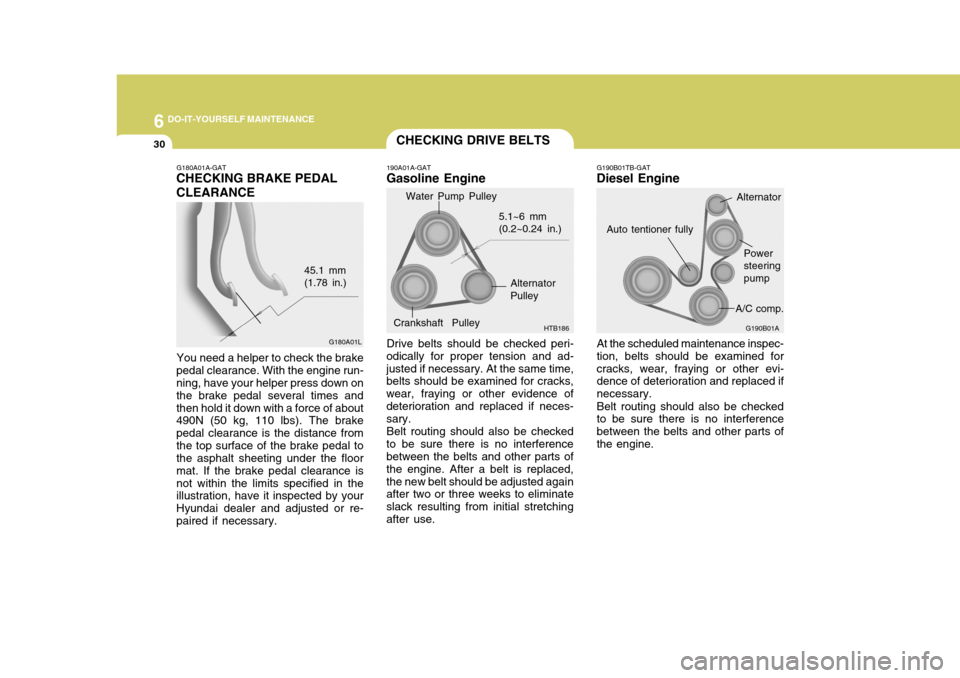
6 DO-IT-YOURSELF MAINTENANCE
30
Water Pump Pulley
Alternator Pulley
Crankshaft Pulley 5.1~6 mm(0.2~0.24 in.)
HTB186
G190B01A
Power steeringpump
A/C comp.
Auto tentioner fully
Alternator
G190B01TB-GAT
Diesel Engine
At the scheduled maintenance inspec- tion, belts should be examined forcracks, wear, fraying or other evi- dence of deterioration and replaced if necessary. Belt routing should also be checked to be sure there is no interference between the belts and other parts ofthe engine.
190A01A-GAT
Gasoline Engine
Drive belts should be checked peri-
odically for proper tension and ad-justed if necessary. At the same time, belts should be examined for cracks, wear, fraying or other evidence ofdeterioration and replaced if neces- sary.
Belt routing should also be checked
to be sure there is no interferencebetween the belts and other parts of the engine. After a belt is replaced,the new belt should be adjusted again after two or three weeks to eliminate slack resulting from initial stretchingafter use.
G180A01A-GAT
CHECKING BRAKE PEDAL CLEARANCE
G180A01L
45.1 mm (1.78 in.)
You need a helper to check the brake
pedal clearance. With the engine run- ning, have your helper press down on the brake pedal several times andthen hold it down with a force of about 490N (50 kg, 110 lbs). The brake pedal clearance is the distance fromthe top surface of the brake pedal to the asphalt sheeting under the floor mat. If the brake pedal clearance isnot within the limits specified in the illustration, have it inspected by your Hyundai dealer and adjusted or re-paired if necessary. CHECKING DRIVE BELTS
Page 244 of 277
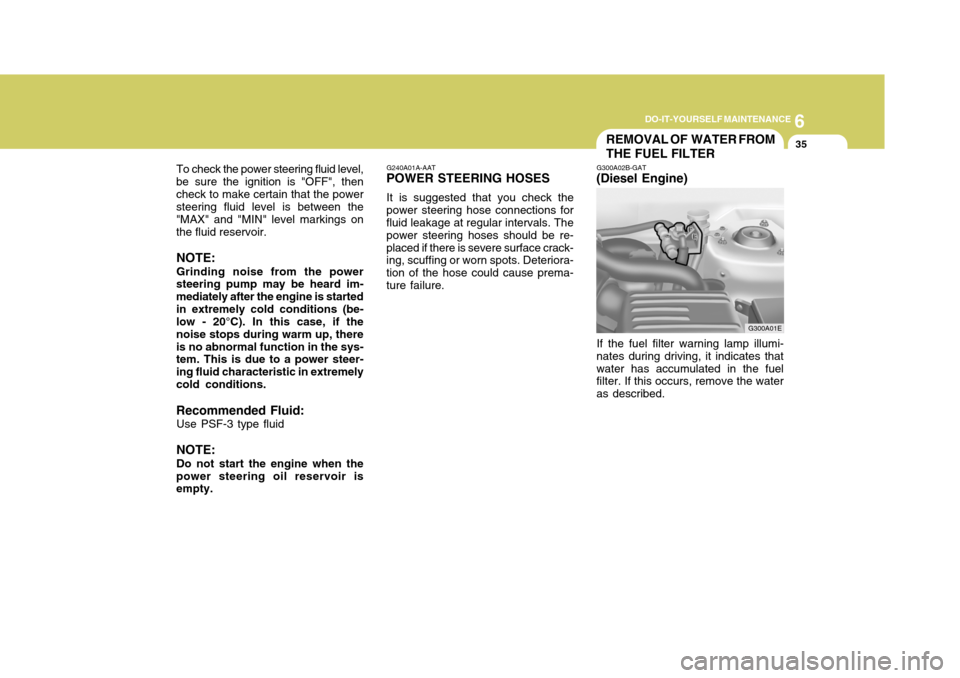
6
DO-IT-YOURSELF MAINTENANCE
35REMOVAL OF WATER FROM THE FUEL FILTER
G300A02B-GAT
(Diesel Engine)
G300A01E
G240A01A-AAT
POWER STEERING HOSES
It is suggested that you check the
power steering hose connections for fluid leakage at regular intervals. The power steering hoses should be re-placed if there is severe surface crack- ing, scuffing or worn spots. Deteriora- tion of the hose could cause prema-ture failure.
To check the power steering fluid level,
be sure the ignition is "OFF", thencheck to make certain that the power steering fluid level is between the "MAX" and "MIN" level markings onthe fluid reservoir.
NOTE: Grinding noise from the power
steering pump may be heard im- mediately after the engine is startedin extremely cold conditions (be- low - 20°C). In this case, if the noise stops during warm up, thereis no abnormal function in the sys- tem. This is due to a power steer- ing fluid characteristic in extremelycold conditions. Recommended Fluid:
Use PSF-3 type fluidNOTE: Do not start the engine when the
power steering oil reservoir is empty. If the fuel filter warning lamp illumi-
nates during driving, it indicates that water has accumulated in the fuel filter. If this occurs, remove the water as described.